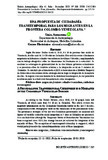| dc.rights.license | http://creativecommons.org/licenses/by-nc-sa/3.0/ve/ | es_VE |
| dc.contributor.author | Urán, Alexandra | |
| dc.date.accessioned | 2023-11-13T14:06:35Z | |
| dc.date.available | 2023-11-13T14:06:35Z | |
| dc.date.issued | 2023-11-13 | |
| dc.identifier.uri | http://www.saber.ula.ve/handle/123456789/49960 | |
| dc.description.abstract | Según Naciones Unidas desde el 2010, 6,4 M de personas han salido de Venezuela. 5,6 M venezolanos están en América Latina y el Caribe, de ellos más de 2,4 M están en Colombia. Este artículo inicia revisando el fenómeno migratorio en la frontera colombo-venezolana en las últimas 5 décadas, que luego es complementado con un trabajo etnográfico sobre las dimensiones del fenómeno en la actualidad. Se analizan además las estrategias de gobernabilidad de los dos últimos gobiernos colombianos y se presentan cifras de algunas variables relativas a la integración social recogidas en 5 ciudades de Colombia. Se concluye que si bien desde el año 2021 se ha reconocido el Estatuto Temporal de Protección a venezolanos -ETPV- dicha estrategia aún no logra la integración de la mayoría de ellos. Se sugiere el reconocimiento de la ciudadanía transtemporal, la cual permitiría resolver en parte la actual crisis humanitaria de estos inmigrantes. | es_VE |
| dc.language.iso | es | es_VE |
| dc.rights | info:eu-repo/semantics/openAccess | es_VE |
| dc.subject | Migración | es_VE |
| dc.subject | Frontera colombo-venezolana | es_VE |
| dc.subject | Ciudadanía transtemporal | es_VE |
| dc.title | Una Propuesta de Ciudadanía Transtemporal para los Migrantes en la Frontera Colombo-Venezolana | es_VE |
| dc.title.alternative | A Proposal for Transtemporal Citizenship for Migrants in the Colombian-Venezuelan Border | es_VE |
| dc.type | info:eu-repo/semantics/article | es_VE |
| dc.description.abstract1 | According to the United Nations, 6.4 million people have left Venezuela since 2010. 5.6 M Venezuelans are in Latin America and the Caribbean, of which more than 2.4 M are in Colombia. This article begins by reviewing the migration phenomenon in the Colombian-Venezuelan border in the last 5 decades, and then complements it with an ethnographic work on the current dimensions of the phenomenon. It also analyzes the governance strategies of the last two Colombian governments and presents figures on some variables related to social integration collected in five Colombian cities. It is concluded that although the Temporary Statute for the Protection of Venezuelans -ETPV- has been recognized since 2021, this strategy has not yet achieved the integration of most of them. It is suggested the recognition of transtemporary citizenship, which would allow to solve in part the current humanitarian crisis of these immigrants. | es_VE |
| dc.description.colacion | 215-254 | es_VE |
| dc.description.email | alexandra.uran@udea.edu.co | es_VE |
| dc.description.frecuencia | Semestral | es |
| dc.description.paginaweb | https://saber.ula.ve/boletin_antropologico/ | es |
| dc.identifier.edepositolegal | ppi201403ME788 | es |
| dc.identifier.eissn | 2542-3304 | es |
| dc.publisher.pais | Venezuela | es_VE |
| dc.subject.institucion | Universidad de Los Andes | es_VE |
| dc.subject.keywords | Migration | es_VE |
| dc.subject.keywords | Colombian-venezuelan border | es_VE |
| dc.subject.keywords | Transtemporal citizenship | es_VE |
| dc.subject.seccion | Boletín Antropológico: Artículo de Investigación | es_VE |
| dc.subject.tipo | Revistas | es_VE |
| dc.type.media | Texto | es_VE |
| dc.identifier.doi | https://doi.org/10.53766/BA/2023.02.106.02 | |
| dc.contributor.orcid | https://orcid.org/0000-0002-6835-4839 | es |


